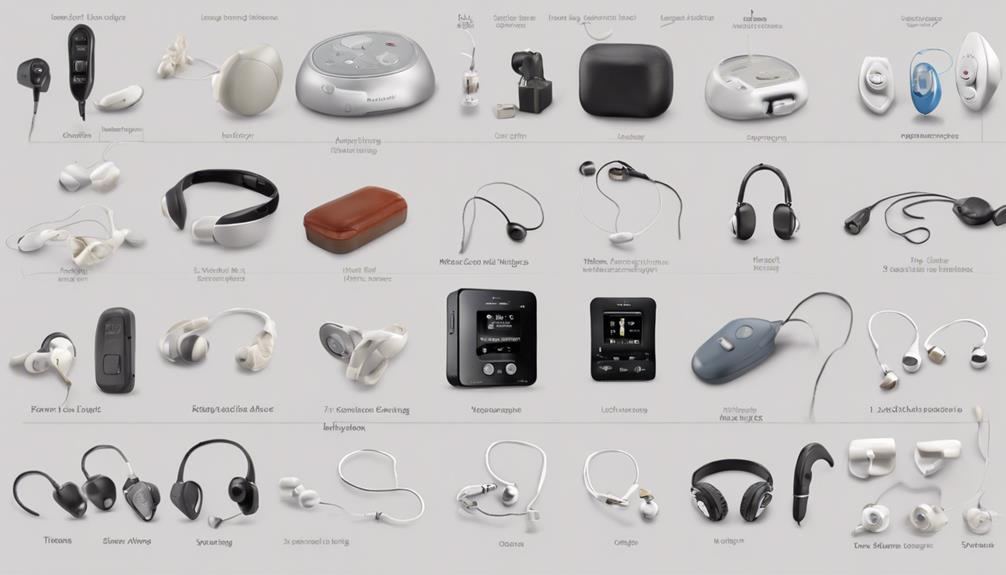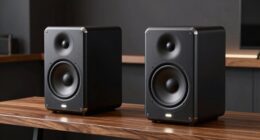If you’re choosing between table microphones and ceiling arrays for your boardroom, consider your room’s size, flexibility needs, and aesthetic goals. Table microphones are easy to install, portable, and great for dynamic setups. Ceiling arrays offer a clean, discreet look, ideal for a sleek environment but are more complex to install. If you want to explore which option fits your space best and learn more about their pros and cons, keep going.
Key Takeaways
- Table microphones offer flexible placement and quick setup, ideal for dynamic boardroom environments.
- Ceiling arrays provide a clean, unobtrusive look but involve more complex installation processes.
- Wireless options in table microphones enhance adaptability and reduce cable clutter; ceiling array wireless solutions are more complicated.
- Ceiling arrays are suited for uniform aesthetics and fixed configurations, while table mics support easy reconfiguration.
- Both solutions should be evaluated for environmental impact, with wireless options generally being more sustainable.

When choosing audio solutions for your boardroom, understanding the differences between table microphones and ceiling arrays is essential. Each option offers distinct advantages and challenges, especially when it comes to wireless connectivity and installation complexity. If you prioritize flexibility and minimal wiring, wireless connectivity becomes a key factor. Table microphones often come with wireless options, allowing you to place them anywhere on the table without worrying about cable clutter. This makes setup cleaner and more adaptable to changing room layouts. Ceiling arrays, on the other hand, typically rely on wired connections or network-based systems, which can add to installation complexity. While some modern ceiling array systems support wireless integration, they often require more extensive planning and infrastructure, especially if you’re retrofitting an existing space.
Additionally, the emphasis on ESG considerations in modern investments underscores the importance of choosing sustainable and responsible audio-visual solutions that minimize environmental impact. With table microphones, installation is generally straightforward. You can connect them directly to your audio system via wireless links or simple wired connections. This ease of installation means less disruption and a faster setup process. You just place the microphones where they’re most effective and connect them to your existing system, making them ideal for spaces that need quick upgrades or frequent reconfiguration. Ceiling arrays, however, demand more careful planning. Installing ceiling-mounted microphones involves running cables through ceilings, mounting the units securely, and integrating them with your audio network. This process can be time-consuming and may require professional installers, especially if your room’s infrastructure isn’t already wired for such systems. The installation complexity can increase further if you want to incorporate wireless features into ceiling arrays, as it may involve additional hardware and network configuration.
In terms of wireless connectivity, table microphones often lead the way because they are designed with mobility and ease of use in mind. They can connect directly to your system via Bluetooth, Wi-Fi, or dedicated wireless transmitters, giving you flexibility in placement and reducing the need for extensive wiring. Ceiling arrays are increasingly offering wireless options, but these tend to be more complex to implement and may involve higher costs. If your priority is a clean, clutter-free environment with minimal installation effort, table microphones with wireless connectivity are usually the better choice.
Ultimately, your decision hinges on balancing installation complexity and wireless flexibility. If you want quick deployment and easy adjustments, table microphones are typically more suitable. If your room demands a discrete, uniform appearance and you’re prepared for a more involved installation process, ceiling arrays might be the better fit. Understanding these differences helps you choose the right solution that aligns with your operational needs and technical capabilities.
Frequently Asked Questions
Which Microphone Type Offers Better Sound Quality in Large Conference Rooms?
In large conference rooms, the microphone type that offers better sound quality depends on your needs. Generally, ceiling arrays provide superior audio clarity because they can focus on voices while reducing background noise from multiple directions. They offer consistent sound pickup across the room. On the other hand, table microphones might struggle with background noise, but they can be more direct. Choose based on your room’s acoustics and desired audio clarity.
How Do Installation Costs Compare Between Table Microphones and Ceiling Arrays?
When comparing installation costs, you’ll find ceiling arrays often have higher upfront expenses due to installation complexity and the need for ceiling modifications. They require more planning and professional setup, which can increase costs. However, they blend seamlessly with your room’s aesthetic, offering a cleaner look. Table microphones are simpler and cheaper to install, but they might not integrate as well visually. Your choice depends on your budget and aesthetic priorities.
Can Ceiling Arrays Effectively Pick up Voices From Distant or Obstructed Speakers?
Ceiling arrays can effectively pick up voices from distant or obstructed speakers because they use multiple microphones to focus on sound sources across the room. They improve voice projection and help minimize background noise, ensuring clear audio even when speakers aren’t directly in front of the microphone. This makes them suitable for larger or more complex spaces, where capturing all participants’ voices is essential for effective communication.
Are There Maintenance Differences Between Table Microphones and Ceiling Array Systems?
You’ll find that maintenance varies between table microphones and ceiling array systems. Table microphones often need regular cleaning routines to prevent dust and debris from affecting sound quality. Ceiling arrays usually require periodic calibration to guarantee peak pickup patterns and performance. While both need some upkeep, ceiling arrays might need more technical calibration, whereas table microphones focus more on physical cleaning. Understanding these differences helps you keep your system functioning smoothly.
Which Microphone Setup Is More Adaptable for Future Technology Upgrades?
Did you know that 75% of businesses plan tech upgrades within five years? When choosing a microphone setup, you should consider future compatibility. Ceiling arrays often feature modular designs, making them easier to upgrade with wireless compatibility options. This adaptability allows you to incorporate new technology seamlessly. So, if you want a flexible system that grows with your needs, ceiling arrays might be the smarter choice for future upgrades.
Conclusion
So, whether you prefer table microphones that seem to shout directly into your face or ceiling arrays quietly listening from above, both have their quirks. It’s almost poetic—one’s in your lap, the other’s out of sight, yet both aim to capture your brilliance. Ironically, the choice boils down to what’s less distracting: a microphone that’s in your face or one that’s silently watching from above. Either way, your voice gets heard—loud or discreet.











